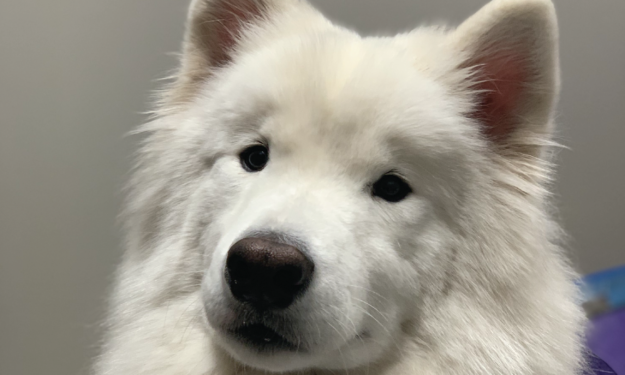Breed of the Month – November – Samoyed

Time to unveil our November Breed of the Month! This month, we are focusing on the beautiful Samoyed!
These working dogs are easily recognizable by their thick white coat that can protect them from well below freezing temperatures. The Samoyed are more powerful than you may think and possess a driven attitude. Similar to breeds such as the Husky or the Malamute, a Sammy can become unhappy and develop destructive behavior if they aren’t given a job to do and a way to release energy.
On average, the Samoyed can stand anywhere from 19-23.5 inches and weigh anywhere from 35-65 pounds. The life span of a Samoyed tends to be around 12-14 years.
As with all dogs, it is best to discuss with your veterinarian which food would best suit your dog. Your veterinarian can also assist with figuring out how much should be fed and how often. It’s important to monitor your dog’s weight to keep them healthy in the long run.
Now let’s discuss one of the biggest factors of owning a Samoyed, their coat! Since these dogs were bred to handle colder temperatures, they carry a very thick double coat that will absolutely shed often and even more so during shedding season. It is advised to brush your Samoyed daily to help avoid mats and dirt build-up.
Samoyeds are more on the healthier side of breeds but it is still important to have them scheduled for yearly wellness exams to catch any diagnoses as early as possible. According to the Samoyed Club of America, it is recommended to have the following health tests performed:
- Ophthalmologist Evaluation
- Hip Evaluation
- PRA Optigen DNA Test
- Cardiac Exam
- RD/OSD DNA Test
Check out this interesting information about the Samoyed, provided by the American Kennel Club:
The name Samoyed comes from the Samoyede, a semi-nomadic people from Asia who migrated to Siberia a thousand years ago; primitives of the family of Sayantsi, they are described as a race in the “transition stages between the Mongol pure and the Finn.” They bred dogs for hard work in the coldest habitable places on earth. In the Siberian town of Oymyakon, for instance, temperatures of minus-60 degrees are common. The Samoyede people lived in tents and huddled for warmth with their dog packs during the Arctic nights. This type of human-canine cooperation for mutual survival forged a tight bond between Samoyeds and people. When not sledging heavy loads across vast expanses of Siberia, Samoyed dogs earned their feed as watchdogs and hunters.
The Samoyede depended on reindeer as a vital source of food, fur, and leather. At first, they used their dogs to hunt reindeer. But in time Samoyede culture shifted from hunting reindeer to herding them. The bold white hunting dogs and haulers found a new role as stock dogs, moving and protecting the herds.
In the late 18th century, Arctic adventurers returning to England introduced the Samoyed to British dog lovers of refined tastes. Queen Alexandra was an admirer who did much to promote the breed as a companion and show dog. In America, a sparkling white dog named Moustan of Argenteau made history in 1906 as the first of the breed (then known as the Samoyede) registered by the AKC. American and European mushers of the early 20th century knew the Samoyed as an enthusiastic hauler of supplies, capable of sledging one and a half times their own weight. Scott, Shackleton, and Amundsen are a few of the era’s famous explorers who rode behind Sammies through uncharted frozen wastelands.
If you’d like to read more about these gorgeous dogs, head on over to https://www.akc.org/dog-breeds/samoyed/ or https://www.samoyedclubofamerica.org.